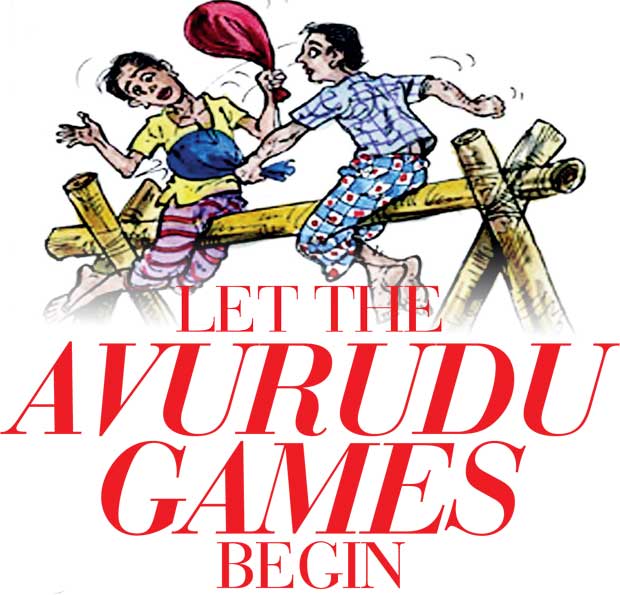Reply To:
Name - Reply Comment

Sri Lankans are indeed blessed with an assortment of traditional games during the Sinhala and Tamil New Year. Reaping the harvest of the Maha season, the rural folk joyfully engage in these games in the month of ‘Bak.’ While the games are never cutthroat, the significance of them is that they are designed to meet the needs of the peasantry whose sole objective is achieving physical and mental satisfaction after constant toiling in every other month of the year. Cascading like a waterfall from generation to generation, these traditional games are played during the apex period of ‘Nonagathaya’ (auspicious time) between the old and new year.
Chaturanga or Chess, Olinda Keliya (the game of liquorices), Pancha keliya (the game of cowries), Nerenci, Gal Keteema (stone slinging), Guduviduma (driving stones), Gudu Paneema, Kamba Adeema (tug of war), Pora Pol Gaseema, Lanu Paneema, Amba Ata Paneema (Mango Kernel Play), Gas Kotu Bandeema (running from tree to tree), Wala Kadju Gaseema, Kotta Pora, Onchili Padeema, Eluwan Keema and Ang Adeema are some of the traditional games played during this festive season.
Chess, Gal Keteema, Nerenci and the games of liquorices and cowries are a few of the many indoor games. They are usually played among family members, neighbours and at times visitors.
Outdoor games such as Eluwan Keema (Goat Play), Ang Adeema, Gudu Paneema, Kamba Adeema, Pora Pol Gaseema, Lanu Paneema, Amba Ata Paneema, Elle and Gas Kotu Bandeema are played during the New Year season.
Olinda Keliya, Pancha keliya, Nerenci, Gudu Gaseema, Sokari, Amba Ata Paneema, Muthu Keliya (the game of pearls) and beating Udakki are some of the games connected to religious beliefs and rites. Most of them are played to please Goddess Pattini. Playing the swing is a game dedicated to Sun God -- the ups and downs of the swing indicate the sunrise and sunset respectively.
Pancha keliya or the game of cowries is a famous indoor game, mostly played by the Southerners. They start playing by the end of March and continue till Vesak, and sometimes Poson. Pancha keliya has a long history. It is believed that King Gajabahu brought back some 12,000 detainees from the Chola dynasty in India, and as revenge, brought an equal number of Cholas together with the anklet of Goddess Pattini. Thus, Pancha keliya is regarded as a game of Goddess Pattini.
The Tamil word ‘Panca’ (meaning ‘Oysters’ or ‘Cowries’) is used in this game. It also uses the words ‘Ondru’ and ‘Rendru’ to refer to integers one and two accordingly. ‘Panca Peta’ (draft board) is designed according to Tamil traditions. There is substantial evidence to the effect that the game is greatly influenced by the Tamil community.
Men, women and children play this game together. Peasants believe the blessings of Goddess Pattini could be evoked by playing Pancha keliya. The two sides should have an equal number of players, and no one is left out in the event of an odd number. An additional player is assigned to one side and is called ‘Hungi’ while a member of the other side is given an additional chance to play.
Another game played during the Avurudu season is Olinda Keliya or the game of liquorices. This too is regarded as a game of Goddess Pattini. Olinda or wild liquorices seeds are played on ‘Olinda Poruwa’ - a board with two sets of holes to pocket the seeds. According to history, the game had been popular among women including princesses in the royal court. The board used in royal palaces and those of nobles had been decorated with wood carvings. Olinda Keliya is also played as an outdoor game. Two sides are formed by well-attired girls and they indulged in a two-way recital. The leader of one side recites a line of the poem “Olinda tiyenne koi koi dese,” and the others in the group repeat it. The leader of the opposite side responds “Olinda tiyenne Bangaladese” and the others in her side repeat it. The game ends when the whole poem is completed.
Gal Kireema or balancing of pebbles is yet another New Year game. It is famous among females. Only six pebbles are required to play this game. After deciding the sequence, the first player takes the pebbles in her palm and after throwing them up, collects as many as possible on the side of her palm. She is supposed to collect as many as possible including the compulsory ones marked by the others. The pebbles thus taken by her are those collected by her and the game goes round. ‘Kadju Keliya’ is a game similar to Gal Kireema.
Elu Kotu Bandeema or goat fencing is an outdoor game played by girls. It is also called ‘Eluwan Keema.’ They make a fence to prevent the outsiders from entering it. Those who are inside the fence are imaginary goats and those outside are goat catchers. The catchers recite a line of a poem asking whether they could jump over the fence - “Udin Panindo.” Those who hold hands to make the fence reply “Talla Kadeido”- You will break your chin. Then she pleads, “Vati wandinnan yaluwe denawada eluwa?”- I will kneel down and salute… Will you give the goat? Then the others reply “Koccara keewath oyata nodemiya Eluwa” - Whatever you say or do you will never get the goat. The game comes to an end when the outsiders break in.
Raban Gaseema or beating the tambourine is another form of recreation enjoyed especially by girls and the elderly women during the festive season. Women, young and old, sit round the large drums and beat them rhythmically while singing to the beat. Veterans beat the drum with their hands, elbows and sometimes with their chins. While beating the drum, they occasionally clap. Songs are worded in keeping with their day-to-day activities. “Bolan podi nangi tikak hitapan, Bulath wita kanta tikak hitapan, Kandan goda ganta tikak hitapan”- Oh dear sister, wait a moment to chew betel, to take the logs in. Another goes as “Udin udin wara pettappu, Bimin bimin wara pettappu.” A parrot is requested to fly or walk in this rhyming game. Young men dance to the tune of the music making the scene more melodious.
Playing on the swing is another way of merrymaking. This is recreation dedicated to the Sun God. Ups and downs of the swing indicate sunrise and sunset. Girls get on the swing hung on an overhead branch of a shady tree. One of the girls sits on the swing while another stands behind. Others give it a push while singing “waram” or quatrains. “Wawlan lesa karakena onchilla, apith padimu dan ran onchilla”– Let us play on the golden swing which turns like a bat.
There is yet another New Year game played by the girls with the use of an ornament worn by one of them. This is called ‘Mewara Keliya.’ More than five girls should participate in this game. One of them hides her bangle in the sand, pretending she had lost it. She then questions the others whether they have found it.” Sara sadisi pethi thora nelana kala walagiyado mage mewaraya.” – I feel that I have lost my ornament while plucking Pethi thora. Others reply: “Nano numbapal nube daruwan pal api dutuwe natha mewaraya.” Oh sister believe us, we have not seen your ornament. At last the owner hops to the music of the song and gets closer to the place where she had hidden the bangle saying she had found it.
Pora Pol Gaseema (coconut match) is another traditional game played by throwing husked coconuts at each other until a coconut held by one of the players is broken.
Certain villages like Ang Kelipitiya, Ang Warama, Udugambawa and Yatigambawa appear to have been named after the game of Ang Adeema (tugging on horns). This game had been very popular in the past. When King Gajaba brought some 12,000 men from the Chola dynasty, the statues of Kannagi, Goddess Pattini and Palanga, her husband were also brought. Hindus believe these statues have divine power. When Kannagi and Palanga were plucking flowers, their hooked sticks entangled and when they pulled them, Kannagi’s hooked stick was broken.
In another story, a king had beheaded Palanga, and Kannagi had cursed the king and the country. As a result, the country was set ablaze. The people had Ang Keliya to appease Kannagi.
At the auspicious moment, a five to six feet deep hole is dug and a log of Kekuna is erected turning the top corner of the log towards the ground. This log is called the Ang Kanuwa. Later, an Areca flower is tied to it and it is called ‘Walimala.’ Close to Ang Kanuwa, another log is erected (Buhukanuwa). Horns are made of Pihimbiya, Andara or Akkiri. Two teams are formed as Udupila and Yatipila. Udupila is Palangi’s and Yatipila is Kannagi’s. It is believed that a win for Kannagi’s Yatipila is a good fortune.